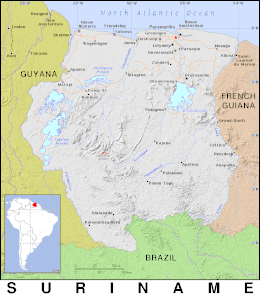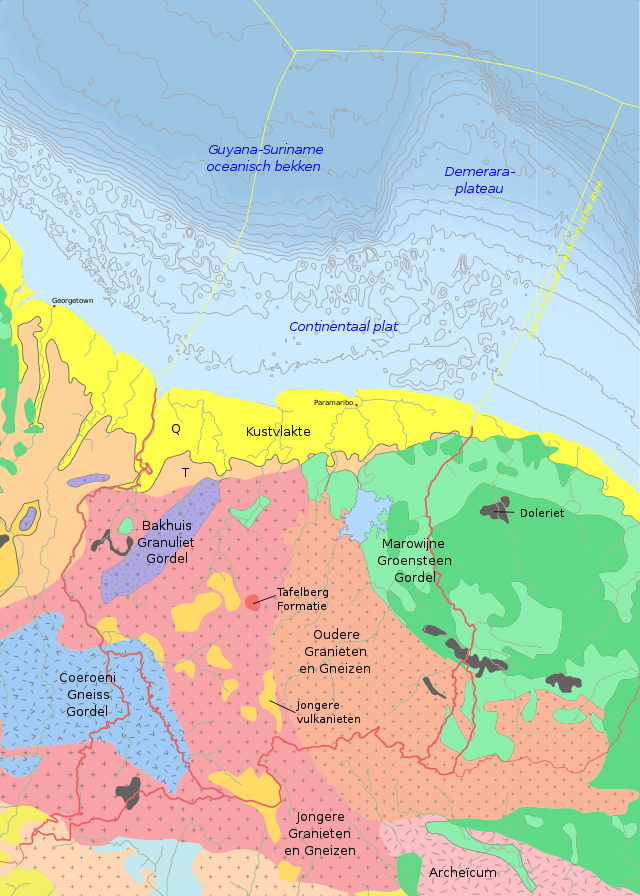Geography_of_Suriname
Suriname is located in the northern part of South America and is part of Caribbean South America, bordering the North Atlantic Ocean, between French Guiana and Guyana. It is mostly covered by tropical rainforest, containing a great diversity of flora and fauna that, for the most part, are increasingly threatened by new development. There is a relatively small population, most of which live along the coast.
This article may require cleanup to meet Wikipedia's quality standards. The specific problem is: Condense sections and remove areas with no information. (April 2013) |
 | |
| Continent | South America |
|---|---|
| Region | Caribbean |
| Coordinates | 4°00′N 56°00′W |
| Area | Ranked 90th |
| • Total | 163,820 km2 (63,250 sq mi) |
| • Land | 95.33% |
| • Water | 4.67% |
| Coastline | 386 km (240 mi) |
| Borders | total length 1,707 km (1,061 mi) |
| Highest point | Juliana Top 1,230 meters (4,040 ft) |
| Lowest point | Caribbean Sea 0 metres (0 ft) |
| Longest river | Courantyne River 724 km (450 mi) |
| Largest lake | Brokopondo Reservoir 1,560 km (970 mi) |
| Exclusive economic zone | 127,772 km2 (49,333 sq mi) |

There are currently two unresolved border disputes that affect the geography of Suriname, namely the Tigri Area in the southwestern region near Guyana and also the Marouini/Litani region with French Guiana in the southeast.
Geographic coordinates: 4°00′N 56°00′W
Continent: South America
Area
Total:
163,820 square kilometers (63,250 sq mi)
Land:
156,000 square kilometers (60,000 sq mi)
Water:
7,820 square kilometers (3,020 sq mi)
Area - comparative: See order of magnitude 1 E+11 m². Slightly larger than Tunisia.
Land boundaries
Total: 1,703 kilometers (1,058 mi)
Border countries:
- Brazil - 593 kilometers (368 mi)
- French Guiana - 510 kilometers (320 mi)
- Guyana - 600 kilometers (370 mi)
Coastline: 386 kilometers (240 mi)
Maritime claims
Exclusive economic zone: 127,772 km2 (49,333 sq mi) and 200 nmi (370.4 km; 230.2 mi)
Territorial sea: 12 nmi (22.2 km; 13.8 mi)
Suriname has a tropical rainforest climate and a tropical monsoon climate, with hot humid conditions year-round.
Climate change in both Suriname and the wider world is leading to hotter temperatures and more extreme weather. As a fairly poor country, its contributions to global climate change have been limited. Suriname has a large forest cover, the country has been running a carbon negative economy since 2014.[1] Hotter temperatures[2] and changes in precipitation trends[3] are predicted because of climate change.
| Climate data for Paramaribo | |||||||||||||
|---|---|---|---|---|---|---|---|---|---|---|---|---|---|
| Month | Jan | Feb | Mar | Apr | May | Jun | Jul | Aug | Sep | Oct | Nov | Dec | Year |
| Record high °C (°F) | 33 (91) |
34 (93) |
35 (95) |
37 (99) |
37 (99) |
36 (97) |
37 (99) |
37 (99) |
36 (97) |
37 (99) |
36 (97) |
36 (97) |
37 (99) |
| Mean daily maximum °C (°F) | 30 (86) |
30 (86) |
30 (86) |
31 (88) |
30 (86) |
31 (88) |
31 (88) |
32 (90) |
33 (91) |
33 (91) |
32 (90) |
30 (86) |
31 (88) |
| Daily mean °C (°F) | 26 (79) |
26 (79) |
26 (79) |
27 (81) |
27 (81) |
27 (81) |
27 (81) |
27 (81) |
28 (82) |
28 (82) |
27 (81) |
26 (79) |
27 (81) |
| Mean daily minimum °C (°F) | 22 (72) |
22 (72) |
22 (72) |
22 (72) |
23 (73) |
22 (72) |
22 (72) |
23 (73) |
23 (73) |
23 (73) |
23 (73) |
22 (72) |
22 (72) |
| Record low °C (°F) | 17 (63) |
17 (63) |
17 (63) |
18 (64) |
19 (66) |
20 (68) |
20 (68) |
15 (59) |
21 (70) |
20 (68) |
21 (70) |
18 (64) |
15 (59) |
| Average rainfall mm (inches) | 200 (7.9) |
140 (5.5) |
150 (5.9) |
210 (8.3) |
290 (11.4) |
290 (11.4) |
230 (9.1) |
170 (6.7) |
90 (3.5) |
90 (3.5) |
120 (4.7) |
180 (7.1) |
2,160 (85) |
| Source: Weatherbase[4] | |||||||||||||
| Climate data for Nieuw Nickerie | |||||||||||||
|---|---|---|---|---|---|---|---|---|---|---|---|---|---|
| Month | Jan | Feb | Mar | Apr | May | Jun | Jul | Aug | Sep | Oct | Nov | Dec | Year |
| Record high °C (°F) | 32.5 (90.5) |
32.4 (90.3) |
32.5 (90.5) |
33.2 (91.8) |
34.8 (94.6) |
34.0 (93.2) |
34.5 (94.1) |
35.6 (96.1) |
35.4 (95.7) |
36.3 (97.3) |
34.9 (94.8) |
33.8 (92.8) |
36.3 (97.3) |
| Mean daily maximum °C (°F) | 28.9 (84.0) |
29.0 (84.2) |
29.2 (84.6) |
29.5 (85.1) |
29.8 (85.6) |
29.8 (85.6) |
30.3 (86.5) |
31.1 (88.0) |
31.7 (89.1) |
31.7 (89.1) |
30.9 (87.6) |
29.8 (85.6) |
30.1 (86.2) |
| Daily mean °C (°F) | 26.5 (79.7) |
26.6 (79.9) |
26.9 (80.4) |
27.2 (81.0) |
27.2 (81.0) |
27.1 (80.8) |
27.2 (81.0) |
27.8 (82.0) |
28.3 (82.9) |
28.2 (82.8) |
27.8 (82.0) |
27.0 (80.6) |
27.3 (81.1) |
| Mean daily minimum °C (°F) | 23.5 (74.3) |
23.7 (74.7) |
24.0 (75.2) |
24.2 (75.6) |
24.2 (75.6) |
23.9 (75.0) |
23.7 (74.7) |
24.0 (75.2) |
24.2 (75.6) |
24.0 (75.2) |
23.9 (75.0) |
23.7 (74.7) |
24.0 (75.2) |
| Record low °C (°F) | 18.3 (64.9) |
18.2 (64.8) |
19.1 (66.4) |
19.9 (67.8) |
20.7 (69.3) |
20.6 (69.1) |
20.9 (69.6) |
19.9 (67.8) |
20.9 (69.6) |
20.3 (68.5) |
20.0 (68.0) |
20.1 (68.2) |
18.2 (64.8) |
| Average rainfall mm (inches) | 191 (7.5) |
114 (4.5) |
111 (4.4) |
191 (7.5) |
246 (9.7) |
316 (12.4) |
266 (10.5) |
168 (6.6) |
61 (2.4) |
61 (2.4) |
79 (3.1) |
176 (6.9) |
1,980 (77.9) |
| Average relative humidity (%) | 82 | 81 | 80 | 80 | 82 | 83 | 82 | 80 | 78 | 78 | 79 | 82 | 81 |
| Source: Deutscher Wetterdienst[5] | |||||||||||||
Most of the country is made up of rolling hills, but there is a narrow coastal plain that has swampy terrain.
A recent global remote sensing analysis suggested that there were 781 km² of tidal flats in Suriname, making it the 34th ranked country in terms of tidal flat area.[6]
Elevation extremes
Lowest point: Unnamed location in the coastal plain - 2 meters (6.6 ft) below Sea Level.
Highest point: Juliana Top - 1,230 meters (4,040 ft)
Natural resources
Timber, hydropower, fish, forests, hydroelectric potential, kaolin, shrimp, bauxite and gold. Small amounts of nickel, copper, platinum and iron ore. It also has sizeable oil.
Water
The country has one large reservoir, the Brokopondo Reservoir. Several rivers run through it, including the Suriname River, Nickerie River and Maroni or Marowijne River.
Land use
(2018 Estimates)
Arable land:
0.4%
Permanent crops:
0.0%
permanent pasture:
0.1%
forest:
94.6%
Other:
4.9%
Irrigated land
510 square kilometers (200 sq mi) (2003)
Natural hazards
Tropical Showers, no hurricanes.[citation needed]
Current issues
Deforestation is a real problem as timber is cut for export. There is also a lot of pollution of inland waterways by small-scale mining activities.
Climate change
Climate change in Suriname is leading to warmer temperatures and more extreme weather events in Suriname. As a relatively poor country, its contributions to global climate change have been limited. Because of the large forest cover, the country has been running a carbon negative economy since 2014.[7]
Suriname was the second country to update its Nationally Determined Contributions in 2020.[8]International agreements
Suriname has agreed to the following agreements: Biodiversity, Climate Change, Endangered Species, Kyoto Protocol, Law of the Sea, Marine Dumping--London Convention, Marine Dumping--London Protocol, Ozone Layer Protection, Paris Accords Ship Pollution, Tropical Timber 94, Wetlands, Whaling[9]
- Northernmost point – Oostelijke Polders
- Southernmost point – Border with Brazil Coeroeni
- Westernmost point – Border with Guyana, Sipaliwini District
- Easternmost point – Border with French Guiana, Sipaliwini District
- Highest point – Julianatop: 1,230 m
- Lowest point – unnamed location on the coastal plain: -2 m
- Tigri Area, an unresolved territorial dispute involving Guyana and Suriname.
- Borders of Suriname, consisting of land borders with three countries: Guyana, Brazil, and France (via French Guiana)
- "Suriname's climate promise, for a sustainable future". UN News. 2020-01-31. Retrieved 2020-06-07.
- "Historical Climate Data Suriname". climateknowledgeportal.worldbank.org. Archived from the original on 2020-06-07. Retrieved 2020-06-07.
- "Climate Data Projects Suriname". climateknowledgeportal.worldbank.org. Archived from the original on 2020-06-07. Retrieved 2020-06-07.
- "Klimatafel von Nickerie / Surinam" (PDF). Federal Ministry of Transport and Digital Infrastructure. Retrieved 21 June 2016.
- Murray, N.J.; Phinn, S.R.; DeWitt, M.; Ferrari, R.; Johnston, R.; Lyons, M.B.; Clinton, N.; Thau, D.; Fuller, R.A. (2019). "The global distribution and trajectory of tidal flats". Nature. 565 (7738): 222–225. doi:10.1038/s41586-018-0805-8. PMID 30568300. S2CID 256767470.
- "Suriname's climate promise, for a sustainable future". UN News. 2020-01-31. Retrieved 2020-06-07.
- "Suriname's Second National Communication - In Progress | UNDP Climate Change Adaptation". www.adaptation-undp.org. Retrieved 2020-06-07.
- "Guyana, or, the Kingdom of the Amazons" is a map from the 1600s of what is now known as Suriname